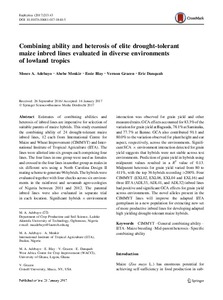| dc.contributor.author | Adebayo, M.A. |
| dc.contributor.author | Menkir, A. |
| dc.contributor.author | Blay, E. |
| dc.contributor.author | Gracen, V. |
| dc.contributor.author | Danquah, E.Y. |
| dc.date.accessioned | 2019-12-04T11:07:42Z |
| dc.date.available | 2019-12-04T11:07:42Z |
| dc.date.issued | 2017 |
| dc.identifier.citation | Adebayo, M.A., Menkir, A., Blay, E., Gracen, V. & Danquah, E. (2017). Combining ability and heterosis of elite drought-tolerant maize inbred lines evaluated in diverse environments of lowland tropics. Euphytica, 213(43). |
| dc.identifier.issn | 0014-2336 |
| dc.identifier.uri | https://hdl.handle.net/20.500.12478/1534 |
| dc.description | Published online: 21 January 2017 |
| dc.description.abstract | Estimates of combining abilities and heterosis of inbred lines are imperative for selection of suitable parents of maize hybrids. This study examined the combining ability of 24 drought-tolerant maize inbred lines, 12 each from International Centre for Maize and Wheat Improvement (CIMMYT) and International Institute of Tropical Agriculture (IITA). The lines were allotted into six groups each comprising four lines. The four lines in one group were used as females and crossed to the four lines in another group as males in six different sets using a North Carolina Design II mating scheme to generate 96 hybrids. The hybrids were evaluated together with four checks across six environments in the rainforest and savannah agro-ecologies of Nigeria between 2011 and 2012. The parental inbred lines were also evaluated in separate trial in each location. Significant hybrids × environment interaction was observed for grain yield and other measured traits. GCA effects accounted for 83.3% of the variation for grain yield at Bagauda, 78.1% at Saminaka, and 77.7% at Ikenne. GCA also contributed 91.1 and 80.0% to the variation observed for plant height and ear aspect, respectively, across the environments. Significant SCA × environment interaction detected for grain yield suggests that hybrids were not stable across test environments. Prediction of grain yield in hybrids using midparent values resulted in a R2 value of 0.13. Midparent heterosis for grain yield varied from 80 to 411%, with the top 36 hybrids recording >200%. Four CIMMYT (EXL02, EXL06, EXL04 and EXL16) and three IITA (ADL33, ADL41, and ADL32) inbred lines had positive and significant GCA effects for grain yield across environments. The novel alleles present in the CIMMYT lines will improve the adapted IITA germplasm in a new population for extracting new set of more productive inbred lines for developing adapted high yielding drought-tolerant maize hybrids. |
| dc.description.sponsorship | Alliance for a Green Revolution in Africa |
| dc.format.extent | 1-12 |
| dc.language.iso | en |
| dc.subject | Maize |
| dc.subject | Drought |
| dc.subject | Environments |
| dc.subject | Cimmyt |
| dc.subject | General Combining Ability |
| dc.subject | Maize Breeding |
| dc.subject | Mid-Parent Heterosis Specific |
| dc.subject | Genetic Materials |
| dc.title | Combining ability and heterosis of elite drought-tolerant maize inbred lines evaluated in diverse environments of lowland tropics |
| dc.type | Journal Article |
| dc.description.version | Peer Review |
| cg.contributor.crp | Maize |
| cg.contributor.affiliation | Ladoke Akintola University of Technology |
| cg.contributor.affiliation | International Institute of Tropical Agriculture |
| cg.contributor.affiliation | University of Ghana |
| cg.contributor.affiliation | Cornell University |
| cg.coverage.region | Africa |
| cg.coverage.region | North America |
| cg.coverage.region | West Africa |
| cg.coverage.country | Nigeria |
| cg.coverage.country | United States |
| cg.isijournal | ISI Journal |
| cg.authorship.types | CGIAR and developing country institute |
| cg.iitasubject | Agronomy |
| cg.iitasubject | Crop Systems |
| cg.iitasubject | Genetic Improvement |
| cg.iitasubject | Maize |
| cg.journal | Euphytica |
| cg.howpublished | Formally Published |
| cg.accessibilitystatus | Limited Access |
| local.dspaceid | 82085 |
| cg.targetaudience | Scientists |
| cg.identifier.doi | https://dx.doi.org/10.1007/s10681-017-1840-5 |

